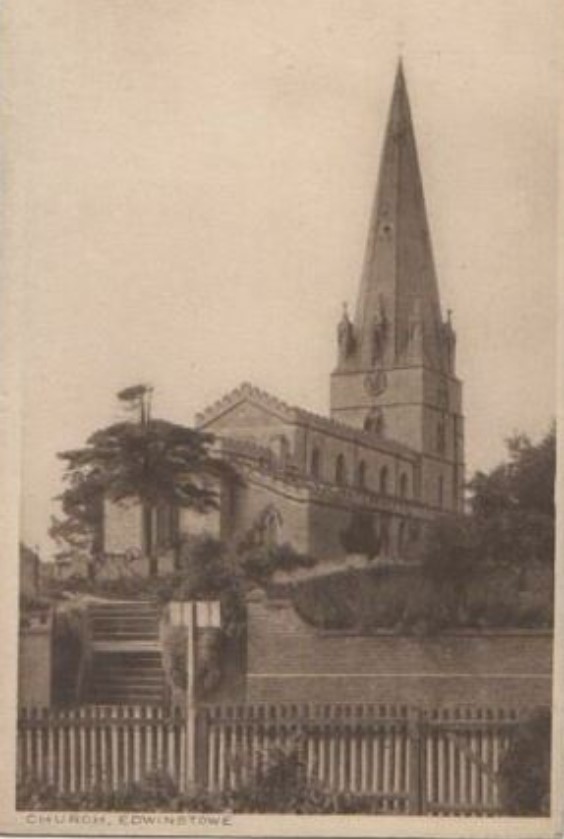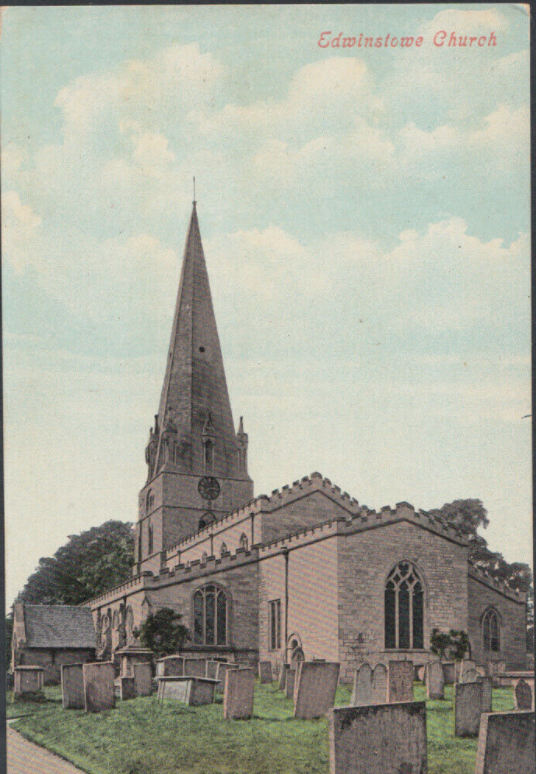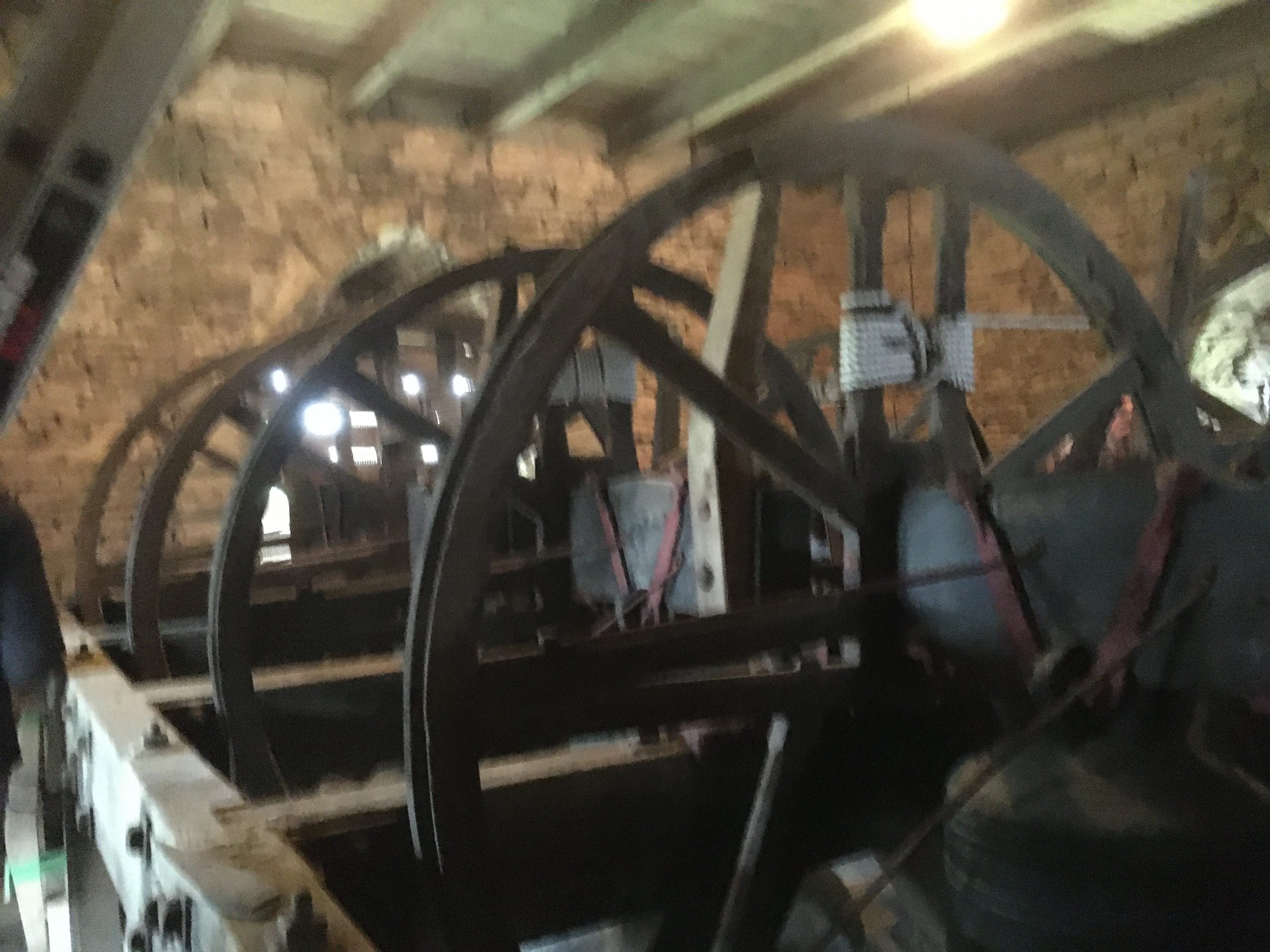
St. Mary’s Church Edwinstowe
Edwinstowe means Edwin’s Holy Place. The name derives from the death of King Edwin of the Mercians, at the Battle of Hatfield in 632. (Probably at nearby Cuckney.)
According to legend the martyred King’s body was temporarily buried here until it could be transported to York. On the edge of Sherwood Forest an iron cross marks the place where
St. Edwin’s Chapel and Hermitage are believed to have stood. In 1084 the Domesday Book states that Edenstow is a Berewick with a church and a priest and four bordars (a poor villein who worked for his lord in exchange for a cottage)
The parish of Edwinstowe was given by William II to the Dean and Chapter of Lincoln before 1146. The ‘Mother church’ of Edwinstowe was responsible for the chapelries of Wellow, Ollerton, Budby, Perlethorpe with Thoresby, Carburton and Clipstone. Surviving from this period are two large, ugly carved faces near the tower, one is sticking its tongue out-perhaps to ward-off evil.
In 1175, it is likely that Henry II, as an Act of Penitence following the murder of Archbishop Thomas a Becket in Canterbury Cathedral, sent masons to rebuild Edwinstowe church in stone. At this period in Clipstone the King’s Houses (also known as King John’s Palace – a favourite Hunting Lodge in the Royal Forest of Sherwood) were being enlarged. The size of the church building and quality of stonework, particularly the carved aristocratic heads, seems surprisingly ambitious for a small village community. Halfway down the nave scholars have identified the head of Henry II glowering at Becket – though sadly there seem to be no records to date these carvings.
This first stone church would have been fairly dark and gloomy. However, in the next century the roof level was raised (the original roof-line is still visible near the tower) and clerestory windows were installed.
Records from York Minster in 1341:

 In 1545, as Henry V111 passed a law so that he could seize the money which belonged to the chantries. At Edwinstowe the chantry priest had died and no one had taken his place so the King took the money, and as a result, the chantry was closed.
In 1545, as Henry V111 passed a law so that he could seize the money which belonged to the chantries. At Edwinstowe the chantry priest had died and no one had taken his place so the King took the money, and as a result, the chantry was closed.
Various unfortunate 19th century ‘restorations’ resulted in the loss of all the original plaster from the walls which would probably have been brightly painted and there’s now only one tiny fragment of ruby-coloured glass remaining in the lower windows, so it is impossible to imagine how the church would have looked.
In 1672, after the spire had been struck by lightning, the inhabitants petitioned Charles II for two hundred decayed oaks from Sherwood to sell for £1 each. Presumably since they were not suitable for ships or building, they would have gone to the charcoal burners in the Forest for use by the local iron works. The total repair bill came to £300 the difference being made up with contributions from local people.
In 1820, the old oak roof was removed, the walls were plastered ‘in medieval style’ and a plaster ceiling was installed. In 1871, lightning again struck the top of the spire and weathercock, which were thrown down through the roof. When Canon Henry Telford Hayman carried out extensive repairs in 1897, the 1820’s ceiling and roof were removed and replaced with a new roof.

St. Mary’s Edwinstowe c1850-1890
Some of the 18th century box-pews were privately owned by the gentry and some rented. For example Reverend Matthew Markham obtained permission from the Duke of Kingston to erect a pew in the chancel for himself and his family. Markham sold his pew to Dr. George Aldrich of Cockglode House who had to apply in writing to take the pew over. There were several disputes which were finally ended in 1848, when the old pews were replaced by bench pews.
Visitors are intrigued by ‘the face in the window’ (a woman’s eye, nose and mouth) appearing in the border of the central panel of the magnificent East Window which was donated by Miss. Catherine Peatfield Cutts. Miss Cutts was the daughter of William and Hannah Cutts. The bequest was in memory of her uncle Henry Cutts who lived at South Farm Carburton and was buried on 26th November 1860 aged 54yrs. She married Walter Symington in 1861 and had several children. The Cutts family double vault is behind the notice board, beside the wall near the gate opposite the Porch.
 Below the details of the window costs and the purchase of a new organ.
Below the details of the window costs and the purchase of a new organ.

St Mary’s Church Organ Information: https://southwellchurches.nottingham.ac.uk/edwinstowe/horgan.php
Lady Chapel In 1341, a double Chantry was built on to the south side of the church with two aumbries and two piscinas. Two priests were paid to pray for John and Cicely Bythewater and their children William, Beatrice and Sarah. Land in North Muskham was granted to the Prior of Newstead to pay for these priests by John’s surviving sons, Henry de Edenstow, King’s Clerk, Canon of Southwell, Lincoln and St Asaph and his brother Robert, the Vicar of Warsop. By 1349, the plague had killed a third of the population of England, so thereafter the Prior of Newstead was only able to supply one priest. When Henry died on 1st February 1350, it is thought that he was buried in front of the altar under a slab carved with a cross and chalice. The priests may well have held a small school for local boys in the chapel.
Long after chantries were abolished by Henry VII, in the 17th century the Chantry House and Dovecote at Edwinstowe were sold. (Nottinghamshire Archives)
This Chantry was dedicated to Our Lady and St. Margaret of Antioch (patron saint of women in childbirth). Together with Archangel Michael, she’s one of the saints whose voice urged St Joan to wear men’s clothing and fight the English. St. Margaret and St. Katherine of Alexandria were really popular with women because their joint feast day was a public holiday! The Cartulary of 1342, instructs: ‘every Custos of the said altar shall every day-except on Double feasts and Sundays, and on the Festival of Saint Katherine and Saint Margaret Virgins-say Mass of the Blessed Virgin’.
Amongst the fine carved heads on the window arches and pillars, facing the door there’s a head with a crudely carved wheel under her chin which could well be St. Katherine. Alongside a modern carving of the Virgin and Child, a carving of St. Margaret was commissioned to fill the empty plinth above the altar to celebrate the Church’s 800th anniversary in 1975.
The Forest Measure


Sited in the North Aisle near the Rigley Memorial it was originally on the outside near the doorway. It was brought inside in 1911 as it was in danger of deteriorating. The Register of Newstead Priory records that, ‘The Forest foot was used in the time of Richard Oysell (Edw.I 1272-1307) for renting the Wastes of the Forest, and was marked & graven in the chancel wall of Edenstowe and in the church of St. Mary Nottingham and Newstede’.
Article from a newspaper in 1908:
“foot” is still extant. When the church was restored, the relic was removed to the South side of the chancel, externally, where it is to be seen by those who have eyes to see and patience to find. It is and a little to the east of the priest’s doorway, and, of a distance of about 12 feet from the ground. The quaint old stone of oblong construction and has a double incised line and above and below while the middle is divided into about 25 sections, in stating these facts will prove of considerable interest to the residents of Edwinstowe, especially when they realise that there is a foot in the wall of their old church probably the only relic of said extant. Even the oldest inhabitants of Edwinstowe – and some are almost within sight of the hundredth milestone- have never heard of the Sherwood Forest Measure, and had little idea that so interesting a relic of a byegone age was associated was associated with Edwinstowe Church.”
During Elizabeth I’s reign in 1587, the Puritan vicar of Edwinstowe, Richard Barton, was presented before the Archdeacon of Nottingham, ‘For not wearing a surplice during the administration of Divine Service’. He stated that he had never worn a surplice since he was vicar.
The original stone altar escaped Queen Elizabeth’s order that all such altars should be broken up as they were popish. In 1584, the Vicar Henry Tinker asked to be buried ‘under the great stone that lieth nere the quere dore.’ In 1911, the Vicar Reverend Edward Bond, a keen antiquarian, rediscovered it in the Belfry. When it was turned over he recognised the consecration crosses and knew it was the missing altar stone. As a memorial to the dead of the Great War, Reverend Frank Cecil Day Lewis had the altar restored to the Chapel in 1921, The Royal British Legion’s Standard hangs there now beside the War Memorial tablets commemorating local men who died in two world wars.
An interesting memorial on the Chapel wall commemorates a Portuguese Jew, William Villa Real, who died in 1759, aged 30 years, leaving a widow and daughter. William’s rich family were driven out of Portugal as the result of a pogrom. His widowed mother married Henry Mellish of Blyth Hall. William’s wife was a Mansfield girl. He bought land and built a house in Edwinstowe. Farm buildings on Mansfield Road at the edge of the village still bear the name Villa Real Farm.
The beautiful stained glass window depicting three Archangels, commemorates Captain James Fane Alexander who lived in Edwinstowe House. His cousin was the Bishop of Derry whose wife, Mrs. Cecil Frances Alexander, wrote many well-loved hymns including, “There is a Green Hill”, “Once in Royal David’s City” and “All Things Bright and Beautiful”.
Stained glass windows – Click here to see more
In 1630, the population was 240. By 1743, Archbishop Herring’s Visitation lists 60 families in Edwinstowe, 20 in Clipstone, Budby 40, ‘4 of the last are Dissenters viz. Papists.’ The sacraments were given twice at Easter, once at Christmas and once on Whitsunday. The Vicar John Merrick who supplied the information had one curate, Alexander Penn, living in the Parsonage on £30 per year.

St. Mary’s. Drawing by S H Grimm c1790
Church Yard
 Although St. Mary’s has a fairly extensive churchyard many of its older tombstones are severely weathered. Dates and inscriptions are difficult to read or in many cases non-existent.
Although St. Mary’s has a fairly extensive churchyard many of its older tombstones are severely weathered. Dates and inscriptions are difficult to read or in many cases non-existent.
The Churchyard was extended in 1868 by 2 rood 12 perch to two and a half acres and is now probably the largest in N. Nottinghamshire. It has a listed stone wall on the south and north of the original site and a hedge around the C19 extension.
The earliest readable stone is one to Ann Oliver who died in 1703; another dating from the early C18th is dedicated to a family of three small children, the eldest only 5, who died within a few days of each other. Nearby is a stone showing the art of an enthusiastic carver who had put all his capital N letters backwards!
I nscriptions in the churchyard range from those giving very basic information of names and dates to those which are very lengthy and full of detail. One is dedicated to two young men who drowned in Thoresby Lake. https://edwinstowehistory.org.uk/local-history/people/families/richard-neil/
nscriptions in the churchyard range from those giving very basic information of names and dates to those which are very lengthy and full of detail. One is dedicated to two young men who drowned in Thoresby Lake. https://edwinstowehistory.org.uk/local-history/people/families/richard-neil/
 Close to the east end of St Mary’s Church is a splendid monument to John Trueman who died in a road accident on his 51st birthday on 3rd May 1853. He became a well-respected entomologist, breeding rare butterflies and moths from Sherwood Forest and selling specimens to collections including the British Museum. His burial was paid for by public subscription. https://edwinstowehistory.org.uk/local-history/people/families/trueman/
Close to the east end of St Mary’s Church is a splendid monument to John Trueman who died in a road accident on his 51st birthday on 3rd May 1853. He became a well-respected entomologist, breeding rare butterflies and moths from Sherwood Forest and selling specimens to collections including the British Museum. His burial was paid for by public subscription. https://edwinstowehistory.org.uk/local-history/people/families/trueman/
 Aurea Alexander was responsible for Setting-up Edwinstowe’s Co-op. She lived in Edwinstowe Hall. Aurea’s ashes were interred in Captain James Fane Alexander’s grave. Their monument is near the Tower beside the hedge. (Archangel window, Lady Chapel).
Aurea Alexander was responsible for Setting-up Edwinstowe’s Co-op. She lived in Edwinstowe Hall. Aurea’s ashes were interred in Captain James Fane Alexander’s grave. Their monument is near the Tower beside the hedge. (Archangel window, Lady Chapel).

As you enter the churchyard from Church Street on the right handside is that of a Bow Street Runner, Henry James Perrener, who died in 1841. https://edwinstowehistory.org.uk/local-history/people/public-servants/
Another, to be found near the main church doorway, is to William Rockley and gives a timely warning to all passers-by!
William Rockley body here is laid, It’s for his sake these lines are made.
That we all here may Remember, He died the 19th September.
Robert Rockley son he be, His age is near to 23 – 1742
Remember you as you pass by, As you are so once was I.
As I am now so must you be, Prepare yourself to follow me.
Another memorial of interest was erected by the 6th Duke of Portland to Thomas White of Clipstone, who worked for 73 years as a woodman in Birklands, dying in 1895 at the age of 89.
 Edwinstowe can claim to have one famous person buried in its churchyard; Dr. Cobham Brewer died at the vicarage in 1897 whilst staying with his daughter, and he is buried here. https://edwinstowehistory.org.uk/local-history/people/author/cobham-brewer/
Edwinstowe can claim to have one famous person buried in its churchyard; Dr. Cobham Brewer died at the vicarage in 1897 whilst staying with his daughter, and he is buried here. https://edwinstowehistory.org.uk/local-history/people/author/cobham-brewer/
Edwinstowe History Society has compiled information of the actual positions and inscriptions of gravestones. A map and list of legible gravestones is kept in the Tower room, also a booklet published by Notts Family History Soc.The churchyard was closed in 1986.
When a national Religious Census was taken in 1851, Edwinstowe with Thoresby had a total population of 1009 –502 males and 507 females. ‘St. Mary’s Ancient Parish Church Space free 140, other 360 total 500. Morning General Congregation 101+Sunday Scholars 73 ; Afternoon General Congregation 98 +Sunday Scholars 73’ (see also Primitive and Wesleyan Methodists Chapels)
St. Mary’s Church Edwinstowe welcomes visitors from all over the world because of the old ballad which says that Robin Hood married Maid Marian at Edwinstowe Church.
Reverend Ebenezer Cobham-Brewer was living with his son-in-law, Canon Henry Telford Hayman at Edwinstowe Vicarage revising his Dictionary of Phrase of Fable in the 1890’s. He died in March 1897, and is buried in Edwinstowe Churchyard.
There is a large tomb near the path on the left facing the car park gate for William and Elizabeth Millns who farmed at Eastfield House Clipstone. Elizabeth Millns paid for a beautiful window of two lights in the Lady Chapel on the South wall. It depicts, ‘Our Lady with Infant Jesus’, & Our Lord as Light of the World. In memory of the brothers and sisters of Elizabeth Millns.
We are also proud of our link with Reverend Frank Cecil Day-Lewis. His son Cecil lived as a young man in the old Vicarage and recalls the sinking of the colliery in his autobiography, The Buried Day. He became Poet Laureate. His son is the actor Daniel Day-Lewis
 Revd Henry Telford Hayman 1884-1907 etc Outiside Vicarage c1889
Revd Henry Telford Hayman 1884-1907 etc Outiside Vicarage c1889
 St Mary’s Edwinstowe Bellringers 1920’s
St Mary’s Edwinstowe Bellringers 1920’s
New Bells for the church – 1889
In 1889 the three old bells were melted down and the metal was used to create six new bells weighing 27CWT (1,372 kg) and costing £300.
A subscription list was opened which raised £193.14s.6d, and a grand Bazaar, opened by Lady Manvers, raised £151. 10s. 61/2d.
The following year a Choir Festival was held to which several local church choirs came, making 100 voices. The Southwell Diocesan Magazine Reports:
“The new peal of bells rang out cheerfully”
(Acknowledgements for research to Margaret Woodhead’s ‘The People of Edwinstowe or The Dead End of the Village and History of the Church and Guide Book for Visitors’)
Bell Ringers St. Mary’s Church

Taken in 1959 after ringing in the New Year
?, John Mabbett, Mr Cowan, Bob Woodhead, Rev. Pickles, Harry Hall, Margaret Hall, Margaret Woodhead.
Bell ringers and choir members outing.
Bob Cauldwell, Mr Harding, Michael Birdsell, Winston Otter, John Mabbott, Paul Kent, Margaret Gascoine, Mrs Hall, Margaret Hall, Mr Cowan, John Gatward, Rev Pickles, Leslie Richardson, Jean Edwards, Marie French, Margaret Hall.
Happy Memories of St. Mary’s
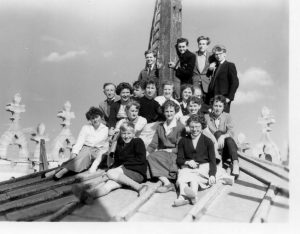
I remember the Youth Club started by Revd. H Pickles, we did square dancing which I loved, led by a young chap called Michael. This was after Sunday Evensong when all the young folk sat in the back pew. Youth Club was held in the Church rooms there was also table tennis but I wasn’t into that. My sister Margaret was on the committee and I usually stayed behind to help her clear up, woe betide us if we were late as Mum gave us a deadline of 9 pm.
Leslie Richardson, Jean Edwardes, Margaret Hall, Marie French,Sylvia Broadhead, Margaret Rose, Ursula Hall, Margaret Gascoine, John Patterson, Colin Rose, Michael Birdsell, Michael Price, Rev Pickles.

St Mary’s Youth Club 1959
Another happy memory comes from the Bell-ringing outings, again my sister was in the ‘campanology’ team and the bell ringers took part in festivals at cathedrals such as Lincoln and York Minster, Mum sometimes came too as Revd. Pickles liked to fill the bus. What a joy to hear so many bell ringers play; wonderful, I loved it.
Colin Rose took photos of us on one occasion when we had climbed the cathedral tower and sat on the roof. I remember Margaret Gascoine was so small she had to stand on a stool to ring.
There was also a special set of bells which were played by hitting with the fist, mostly played by the rector he had a lovely tenor voice and at church concerts would sing “There is a lady passing by.” After I was confirmed at the age of 15 yrs, I always went to 8 a.m, Holy Communion. On Sunday afternoons with my sister Margaret I went to Sundays school eventually doing a teachers’ course, I still have my certificate given by Southwell Minster. I also remember Margret Woodhead – an excellent teacher.
St Mary’s church played a huge part in my life from the age of 4 yrs until I left home aged 18 when I went into nursing. I think all I learnt from St Mary’s laid the foundation for me to become a reader (L.L.M) in later years; I had the privilege of minister to Deaf people for 22 years.
Ursula Coles (Hall)

Bell ringers and choir an outing with Rev. Pickles

Mansfield & District bell ringers at St. Mary’s 1970’s

Bell Ringers 1980’s
 Outing to Evesham Bell Tower
Outing to Evesham Bell Tower
Jayne Kerfoot, Margaret Woodhead, Val Jones, Mandy Staley, Angela Mellors, John Ottaway, Ralph Latham, Hazel Lunnon, Brian Freeman, Carolyn Codd, Elsa Ridsill, Carl Robinson.
Read more about the bells. Click bells to read more.
St Mary’s Members at Drop the Debt Demonstration in Birmingham 13th June 1999

In the 1990’s, 40 villagers took a year to make a Parish Map using cross-stitch, embroidery and collage. The Map has pride of place in St. Mary’s Church.

View Church Leaflet – Open Churches
http://www.nottsopenchurches.org.uk/tourism.php_files/Edwinstowe.pdf
Building, Church Yard
The Southwell churches – Edwinstowe History website click below
http://southwellchurches.nottingham.ac.uk/edwinstowe/hhistory.php
St. Mary’s Edwinstowe Spire Repairs
In the 15th Century the spire, which is an irregular polygon, due to the fact that the tower is wider from east to west than north to south was added. The tower was not built to receive it. It is believed that the faces on corners are of the cardinals of Lincoln Minster.
The spire has been rebuilt on various occasions. In 1679, the parishioners sent a petition to Charles 11 asking for, “200 decaying oaks which are unfit for ship timber” from Sherwood Forest (cost £300) for repairs to the church including the steeple which they reported that, “about seven years ago was beaten down by thunder”. £200 was given and the villagers raised another £100.
The spire was struck again in 1815 and 1871, and the top portion was once again rebuilt. The top metre of the spire and weathercock fell through the roof.
 In 1978, there were further repairs to the tower, spire and walls. Rebuilding work took place to straighten the top of the spire which had been rather clumsily restored on previous occasions. Final repairs took place in 1985. As you can see from the photographs a mammoth task.
In 1978, there were further repairs to the tower, spire and walls. Rebuilding work took place to straighten the top of the spire which had been rather clumsily restored on previous occasions. Final repairs took place in 1985. As you can see from the photographs a mammoth task.
St. Mary’s School Weather Vane Jump Rev. Ford and Michael Jackson 30th Nov 1984
73, Berry Hill Road
Mansfield
In May 1950 a steeple jack firm removed about 20 ft (7m) of the steeple to fix a stainless-steel rod to support the weather vane. Some heathen had used the cock for rifle practice and scored several hits, with damaging results.
I was asked by Mr. Lane the church surveyor if I would repair it before refixing. This I was glad to do, and had to open it up to knock out the dents, and seal up the holes. Inside were 3 copper plates soldered to the sides reading:
- Edwinstowe Church Aug 14th 1816
William Midworth Maker Mansfield
2. J. Ledger, S. Lee Churchwardens
Fisher & Son J. Faulkner Contractor
Rev. W. H. Hotson Vicar
Edwinstowe Church 1871
3. Edwinstowe Church Restored July 18/1871
J.W. Bousefield Mansfield
Bullets damaged the weather vane
Obviously, it was upsetting for Mr. Lane, the church surveyor and the church community that the weathervane had been used for rifle practice. And yes, the culprits were called heathens. However, read this account and perhaps you may form your own conclusion.
“Apart from the rare sighting of passing enemy aircraft, nothing much of the war touched the Edwinstowe in WW11. There was one unforgettable occasion, when a German plane machine-gunned the colliery headstocks and the church spire, and fired a hail of bullets over Second Avenue, narrowly missing Johnny Higginbotham.”
Michael Hayes reporting for the Acorn 2003- Wartime Days
The repairs to the church spire 1985






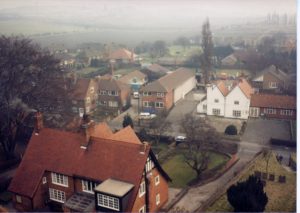
Medieval Graffiti – St Mary’s Church, Edwinstowe
In 2018, St Mary’s Church Edwinstowe, was chosen to be included in the Derbyshire and Nottinghamshire Medieval Graffiti Survey. The project hoped to identify, survey and record existing examples of Medieval graffiti in churches and other historic buildings within the two counties, and ascertain whether they were forms of art, coded messages or merely graffiti.
A summary of the findings was submitted by Andy Hoe, in which he indicated that as Edwinstowe church had been restored in Victorian times, the interior walls were now bare stone with the rendered plaster having been stripped off which made the survival of graffiti very sparse and faint.
Apparently 25 pieces were identified and recorded on the interior and exterior of the church.
On the interior, marks were found in the Nave, on the Altar slab, the South Aisle and the Tower doorway, also the South Porch (initials, double-V witch mark), and what appeared to be an inscribed bow and arrow on the south side of the font. The font is ascribed to the Medieval period, and it is therefore intriguing that a bow and arrow design should be carved on the font, although this is most likely a mason’s mark rather than the romantic suggestion that this may relate to Robin Hood.
On the exterior of the church graffiti was limited to the south buttress, the south wall and the east wall.
 Edwinstowe Historical Society
Edwinstowe Historical Society

